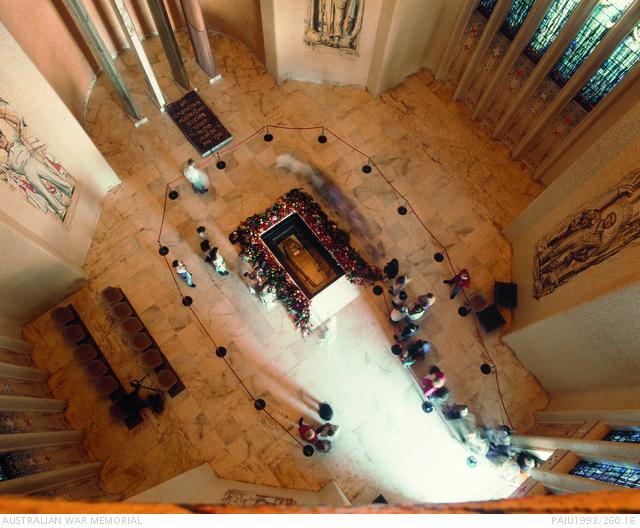All of them, one of us: the Unknown Australian Soldier

"He is all of them. And he is one of us.”
This Remembrance Day marks two significant anniversaries: it will be 95 years since the end of the First World War and 20 years since the remains of an unknown Australian soldier who died in that conflict were interred in the Australian War Memorial’s Hall of Memory.
The entombment of the unknown soldier on 11 November 1993 was a significant and highly emotional occasion for Australians, many of whom had waited decades for the event. The remains had been recovered from Adelaide Cemetery near Villers-Bretonneux in France, where Australian soldiers had won a great victory on Anzac Day 1918. The body was brought home on a specially chartered Qantas flight, with the jet renamed “Spirit of Remembrance” for the trip.
The Unknown Australian Soldier lay in state in King's Hall in Old Parliament House for four days, and thousands of people came to pay their respects. On Remembrance Day, thousands more lined Canberra’s Anzac Parade for the funeral procession to the Memorial, where Prime Minister Paul Keating delivered the eulogy. The speech has drawn comparisons to Lincoln’s Gettysburg Address for its succinct but poignant style:
The Unknown Soldier honours the memory of all those men and women who laid down their lives for Australia. His tomb is a reminder of what we have lost in war and what we have gained … It is not too much to hope, therefore, that this Unknown Australian Soldier might continue to serve his country – he might enshrine a nation's love of peace and remind us that in the sacrifice of the men and women whose names are recorded here there is faith enough for all of us.
The soldier was buried with a bayonet and a sprig of wattle in a Tasmanian blackwood coffin. First World War veteran Robert Comb was given the task of scattering soil from the Pozières battlefield in his tomb. In an unscripted moment, he quietly said: “Now you’re home, mate.”
Millions of visitors, including countless heads of state, have since stood solemnly at the foot of the tomb and bowed, reflecting upon the sacrifice of those who have died in war. But why did it take 75 years?
Britain and France interred unknown soldiers two years after the Armistice, in 1920. A number of other nations followed suit during the next decade, including the United States, Italy, Belgium and Austria. But countries of the British Empire – including Australia, New Zealand and Canada – were expected to see Britain’s Unknown Warrior, entombed in Westminster Abbey, as one of their own.
First World War historian Meleah Hampton says the unknown soldiers in France and Britain were important for the families of men killed in action, “particularly for those with no known grave, or a grave in another country”.
“Many of the visitors to these tombs were thinking of loved ones when they visited, and specifically visited there because of their inability to make a visit to the graveside for significant anniversaries in the traditional manner,” Hampton says. “After all, however unlikely it may seem, the remains in the grave could be their son or husband or father.”
Plans to honour an unknown Australian soldier were first put forward in the 1920s, but opposition was strong. Charles Bean, the founder of the Australian War Memorial, and John Treloar, its first director, were concerned that a tomb would detract from their shared vision of a memorial and museum – which unbeknownst to them was still almost 20 years from being built. Leaders of the organisation that became known as the Returned and Services League, or RSL, also overruled the regional associations that were in support of the plan. Their allegiance was to the unknown British warrior as the representative of all who fought for the Empire.
It was not until the early 1990s that the Memorial and the RSL would relent and recognise that this was an idea for which the time had come.
Hampton says the 75-year interval since the end of the war and the interment of the Unknown Australian Soldier means he has a different significance to that of the unknown soldiers entombed within just a few years of the end of the First World War.
“By 1993 almost all of the people who would visit the tomb and remember a face or a voice were also gone,” she says. “Keating’s eulogy from 11 November 1993 is famous for the words, ‘He is all of them, and he is one of us.’ There is the ring of nationhood and belonging in that statement.
“The Unknown Soldier reinterred in 1993 is a legend – he holds the memory for us, rather than representing memories that we have. He does not necessarily represent the battlefield, the event, or a person; he represents Australia, its people, traditions and nation.”
Former Prime Minister Keating will return to the Australian War Memorial on 11 November to deliver the commemorative address at Remembrance Day, and to again pay respect to the Unknown Australian Soldier.